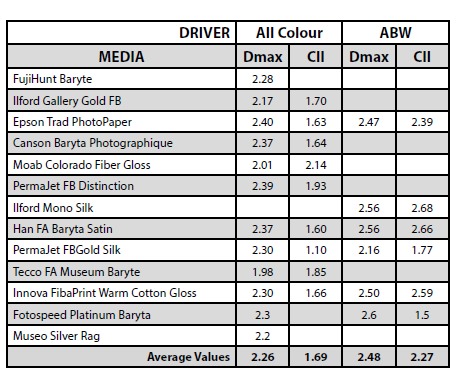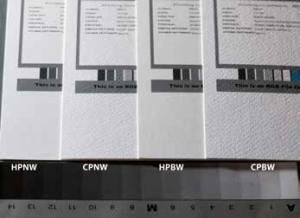articles/Monochrome/mike-mono-page11
Monochrome - choice of the connoisseurs - part 11 of 1 2 3 4 5 6 7 8 9 10 11
by Mike McNamee Published 02/02/2015

The Editor's Picks
For what it is worth, here are the picks we have made. All but two are barytas, the different ones are Permajet Titanium and Tecco Iridium both of which have a 'silvered', 'pearlescent' finish, which has been much admired by monochrome enthusiasts.
The graph of base tones illustrates the initial selection criteria. The neutral point is arrowed. This is the spectrographic neutral for D65 light, that is slightly blue but close to standard daylight viewing. Papers above that point are cream or 'warm toned'. Papers just below also look quite creamy and it is not until you get out below -3 units on the Lab b scale that coolness starts to show. By the time you get out to -10 units you are looking at seriously brightened and cool papers. Such papers depress the tones of skin in colour prints but no such worries apply in monochrome - if you like the 'pop' delivered by a brightened paper then go for it! The only proviso is that the heavily brightened papers tend to yellow with age as the brighteners lose their effect. One thing that most people would agree on is that if you are keen to use a warm-toned image, a warm toned paper will reinforce the effect, there is little point having the two complete. So, by way of example, if you want a cold toning effect you might use Epson Traditional Photo Paper (or go the full nine yards and use PermaJet Distinction); if you want to use a sepia tone then you would veer towards Innova Warm Cotton Gloss or Hahnemuhle Fine Art Baryta Satin. The cluster of papers just below the neutral point also presents as quite creamy and may be used for warm tone mono but are also particularly good for full colour portraiture with their accurate skin tones.
One thing to bear in mind as you ponder over your choice is that within any of the bigger ranges of media you can find every base tone you care to use. For example we show the Lab scatter plot of the Tecco range - all tones are covered somewhere!

Fine Art Alternatives
You might feel your project requires a matt fine art paper, which we have deliberately avoided in our selection. If you are set on this option you might start by looking at the Epson Signature Worthy range. With Dmaxs around 1.6 they just have the edge over some of their rivals and this also manifests itself a higher colour gamuts as well (we have heard it is due to the use of triple coating but have been unable to confirm this). There are two types Hot Pressed and Cold Pressed and it is the Hot Pressed which is smooth surfaced, perhaps more appropriate for monochrome.
If you wish to recreate the effect of charcoal on pastel paper, however, the textured surfaces might be better. Here the Canson Mi-Teintes 170gsm is one of the few media to fulfil this requirement but perhaps we are starting to drift away from our opening brief!
Please Note:
There is more than one page for this Article.
You are currently on page 11
- Monochrome - choice of the connoisseurs page 1
- Monochrome - choice of the connoisseurs page 2
- Monochrome - choice of the connoisseurs page 3
- Monochrome - choice of the connoisseurs page 4
- Monochrome - choice of the connoisseurs page 5
- Monochrome - choice of the connoisseurs page 6
- Monochrome - choice of the connoisseurs page 7
- Monochrome - choice of the connoisseurs page 8
- Monochrome - choice of the connoisseurs page 9
- Monochrome - choice of the connoisseurs page 10
- Monochrome - choice of the connoisseurs page 11
1st Published 02/02/2015
last update 09/12/2022 14:56:44
More Monochrome Articles
There are 29 days to get ready for The Society of Photographers Convention and Trade Show at The Novotel London West, Hammersmith ...
which starts on Wednesday 14th January 2026





